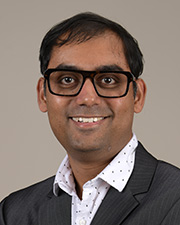
Victor Banerjee, PhD
- Assistant Professor
- Mitchell Center for Alzheimer’s Disease and Related Brain Disorders
Biography
Dr. Victor Banerjee specializes in structural biology, focusing on prion-like protein transmission. After completing his undergraduate studies in chemistry at Jadavpur University, he developed an early interest in the intersection of chemistry and biology, which laid the foundation for his current research. Dr. Banerjee began his scientific career at Bose Institute under the guidance of Prof. K.P. Das, where he explored the role of misfolded proteins in neurodegenerative diseases like Alzheimer’s (AD), Parkinson’s (PD), and Amyotrophic lateral sclerosis (ALS). His doctoral work, which focused on protein aggregation mechanisms, inspired his transition to ALS research in Prof. Niv Papo’s lab, where he developed protein-based agents to inhibit the aggregation of SOD1, a key protein involved in ALS.
During his postdoctoral work at UCSF with Nobel laureate Prof. Stanley Prusiner, Dr. Banerjee honed his expertise in electron cryo-microscopy (cryoEM). He used this technique to study the structural aspects of tau and α-synuclein (αSyn) proteins in diseases like AD and PD. In Prof. Claudio Soto’s lab, he worked on developing biochemical assays for detecting misfolded proteins in ALS patients, correlating the structures with their biological effects. There, he further investigated the structural aspects of infectious prion proteins that cause Chronic Wasting Disease (CWD) in deer and elk. He used cryoEM to reveal the structure of CWD prions and explored their zoonotic risks. Dr. Banerjee has published multiple articles in reputed journals. His primary research interest involves understanding how the structure of protein aggregates influences disease phenotypes.
Education
- Bachelor's Degree (BSc)
- Jadavpur University - Kolkata, West Bengal, India
- Master's Degree (MSc)
- Jadavpur University - Kolkata, West Bengal, India
- Doctorate Degree (PhD)
- Bose Institute - Kolkata, West Bengal, India
Areas of Interest
Research Interests
Neurodegenerative diseases are characterized by the accumulation of misfolded proteins in various regions of the central nervous system. This protein accumulation is toxic and spreads across anatomically connected brain areas. Within these aggregates, the proteins adopt a unique conformation, often β-sheet in nature. The specific structure varies across different diseases, leading to distinct clinical manifestations.
My research focuses on understanding how these unique protein conformations influence disease phenotypes. To achieve this, I employ structural biology techniques, such as electron cryo-microscopy, to investigate the high-resolution structural details of these conformations. Additionally, I use cell and animal models to explore the effects of these structures on disease progression and phenotype.
Publications
- Banerjee V, Das KP. Modulation of pathway of insulin fibrillation by a small molecule helix inducer 2,2,2- trifluoroethanol. Colloids and Surfaces B:Biointerfaces. 2012, 92, 142.
- Banerjee V, Kar RK, Datta A, Parthasarathi K, Chatterjee S, Das KP*, Bhunia A. Use of a small peptide fragment as an inhibitor of insulin fibrillation process: A study by high and low resolution spectroscopy. PLoS One 2013, 8, e72318.
- Banerjee V, Shani T, Katzman B, Vyazmensky M, Papo N, Israelson A and Engel S. A SOD1–derived peptide inhibits amyloid aggregation of fALS SOD1 mutants. ACS Chemical Neuroscience 2016, 7, 1595.
- Banerjee V, Oren O, Zeev IB, Taube R, Engel S, Papo N. A computational-combinatorial identifies a protein inhibitor of superoxide dismutase-1 misfolding, aggregation, and cytotoxicity. Journal of Biological Chemistry 2017, 292, 15777.
- Shvil N, Banerjee V, Zoltsman G, Shani T, Kahn J, Abu-Hamad S, Papo N, Engel S, Bernhagen J, Israelson A. MIF inhibits the formation and toxicity of misfolded SOD1 amyloid aggregates: Implications for familial ALS. Cell Death and Disease 2018, 9, 107.